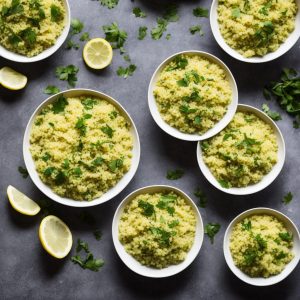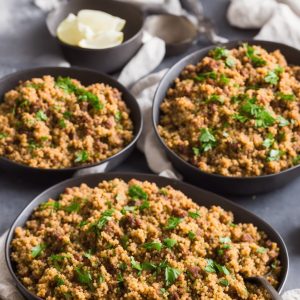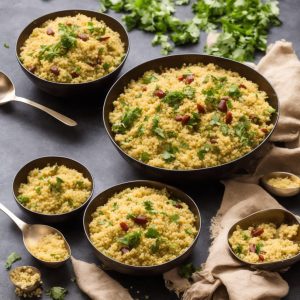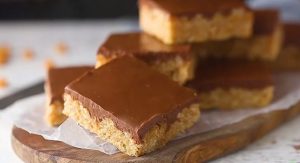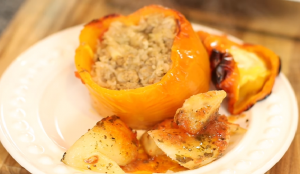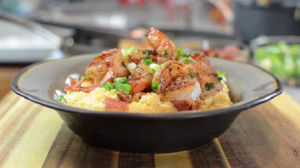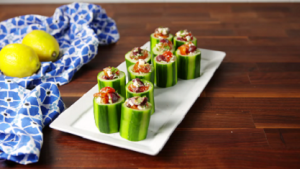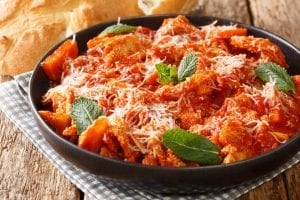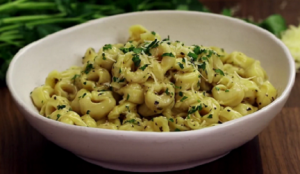Embark on a culinary journey with the Vegetable Couscous Delight recipe. It's an engaging blend of myriad vegetables and couscous, offering a unique texture and flavor profile. This dish is a testament to how simple ingredients can come together to create a hearty, satisfying meal.
The key ingredients for this recipe are couscous and fennel bulb. Couscous, a type of pasta made from semolina flour, might not be a staple in everyone's pantry but can be easily found in the pasta or international aisle of most supermarkets. Then there's the fennel bulb, a vegetable that adds a unique anise-like flavor. If you haven't cooked with it before, you can usually find it in the produce section near other root vegetables.
Ingredients for your Vegetable Couscous Delight
Cooking oil: Used to sauté the vegetables, it helps in bringing out their flavors.
Onion: Adds a sweet and savory depth to the dish.
Carrots: Provides a sweet note and adds to the overall texture of the dish.
Fennel bulb: Adds a unique anise-like flavor to the mix.
Eggplant: Adds a meaty texture and absorbs the flavors well.
Garlic: A crucial ingredient that gives a punch of flavor.
Jalapeño pepper: Adds a hint of heat to the dish.
Tomato paste: Helps in creating a rich and thick sauce for the couscous.
Ground coriander: Adds a warm and nutty flavor.
Caraway seeds: Provides a slightly sweet flavor and an interesting crunch.
Salt: Enhances the flavors of the other ingredients.
Black pepper: Adds a hint of heat and sharpness.
Water: Used to cook the couscous and to create the sauce for the dish.
Chickpeas: Adds protein and a creamy texture to the dish.
Couscous: The star of the dish, it adds texture and absorbs the flavors of the sauce.
One reader, Damara Fitzpatrick says:





This vegetable couscous delight recipe is a game-changer! The blend of flavors is simply divine. The combination of tender vegetables and aromatic spices creates a truly delightful dish. It's easy to prepare and perfect for a healthy, satisfying meal. I highly recommend trying it out!
Mastering the Techniques for Vegetable Couscous Delight
How to sauté vegetables: Sautéing vegetables involves cooking them in a small amount of oil over medium heat until they are tender and slightly browned. This technique adds flavor and texture to the vegetables.
How to cook couscous: Cooking couscous involves boiling water, adding the couscous, and then letting it stand off the heat until the grains absorb the water and become tender. Fluffing the couscous with a fork after cooking helps to separate the grains and create a light, fluffy texture.
How To Make Vegetable Couscous
With tender veggies and chickpeas, this vegetable couscous is bursting with heavenly flavors from jalapeno pepper and tomato paste for a filling dish.
Serves:
Ingredients
- ¼cupcooking oil
- 1large onion
- 4carrots
- 1fennel bulb
- 1eggplant,(about ¾ lbs)
- 4garlic cloves
- 1jalapeno pepper
- ¼cuptomato paste
- 2tspground coriander
- 1½tspcaraway seeds
- 2¼tspsalt
- ¼tspfresh ground black pepper
- 5½cupswater
- 1cupchickpeas,(15 oz can), drained and rinsed
- 1cupcouscous
Instructions
-
In a large saucepan, heat the oil over moderate heat. Add the onion, carrots, fennel, eggplant, garlic, and jalapeño. Cook, covered, for about 10 minutes until the vegetables start to soften.
-
Stir in the tomato paste, coriander, caraway seeds, 2 teaspoons of salt, and black pepper. Cook, stirring, for 1 minute.
-
Add 3½ cups of the water and bring to a boil. Reduce the heat and simmer, uncovered, for about 15 minutes until the vegetables are tender. Add the chickpeas and simmer for 2 minutes longer.
-
In a medium saucepan, bring the remaining water to a boil. Add the remaining salt and the couscous. Cover.
-
Remove the pot from the heat and let the couscous stand for 5 minutes. Fluff with a fork.
-
Serve the stew with its broth over the couscous.
Nutrition
- Calories: 589.23kcal
- Fat: 17.86g
- Saturated Fat: 1.53g
- Trans Fat: 0.05g
- Monounsaturated Fat: 9.62g
- Polyunsaturated Fat: 5.67g
- Carbohydrates: 91.98g
- Fiber: 18.09g
- Sugar: 19.16g
- Protein: 20.02g
- Sodium: 1545.64mg
- Calcium: 143.62mg
- Potassium: 1449.41mg
- Iron: 4.48mg
- Vitamin A: 554.92µg
- Vitamin C: 27.46mg
Expert Tip for Perfecting Vegetable Couscous Delight
When preparing the couscous, it's important to remember not to stir it while it's cooking. Instead, after adding the boiling water, cover it and let it sit off the heat. This allows the couscous to absorb the water evenly, resulting in a fluffy and light texture. Stirring it while it's cooking can lead to a mushy consistency. After it has rested for the recommended time, use a fork to fluff it up, separating the grains gently. This will give your couscous the perfect texture to complement the hearty vegetable stew.
Time-Saving Tips for Preparing This Couscous Recipe
Prep ahead: Chop and prepare all your vegetables and ingredients in advance to save time during the cooking process.
One-pot wonders: Look for recipes that allow you to cook everything in one pot or pan to minimize cleanup and save time.
Batch cooking: Make a larger portion of the recipe and store the extra servings for quick and easy meals throughout the week.
Time-saving tools: Utilize kitchen tools such as food processors, mandolines, and slow cookers to expedite the cooking process.
Follow the recipe: Stick to the recipe and its instructions to avoid mistakes that could lead to time-consuming fixes.
Efficient organization: Keep your kitchen organized and clean as you cook to save time and minimize distractions.
Substitute Ingredients For Vegetable Couscous Recipe
cooking oil - Substitute with olive oil: Olive oil is a healthier alternative and adds a rich flavor to the dish.
onion - Substitute with shallots: Shallots have a milder flavor and can add a subtle sweetness to the dish.
carrots - Substitute with butternut squash: Butternut squash has a similar sweet and nutty flavor, and it adds a vibrant color to the dish.
fennel bulb - Substitute with celery: Celery provides a similar crunchy texture and a mild, slightly sweet flavor.
eggplant - Substitute with zucchini: Zucchini has a similar texture and mild flavor, and it cooks quickly like eggplant.
garlic - Substitute with garlic powder: Garlic powder can be used as a substitute for fresh garlic, providing a convenient option with a milder flavor.
jalapeno pepper - Substitute with green bell pepper: Green bell pepper can add a mild, sweet flavor without the heat of jalapeno.
tomato paste - Substitute with canned tomatoes: Canned tomatoes can be used as a substitute for tomato paste, providing a similar tomato flavor and texture.
ground coriander - Substitute with cumin: Cumin has a warm, earthy flavor that can be used as a substitute for coriander.
caraway seeds - Substitute with fennel seeds: Fennel seeds have a similar licorice-like flavor and can be used as a substitute for caraway seeds.
chickpeas - Substitute with cannellini beans: Cannellini beans have a creamy texture and mild flavor, making them a suitable substitute for chickpeas.
couscous - Substitute with quinoa: Quinoa is a nutritious alternative to couscous and provides a similar texture and nutty flavor.
Presenting Vegetable Couscous Delight in Style
Elevate the couscous: Create a perfectly shaped mound of couscous using a ring mold for a clean and elegant presentation.
Artful vegetable arrangement: Arrange the cooked vegetables and chickpeas in a visually appealing manner around the couscous, creating a colorful and vibrant display on the plate.
Garnish with fresh herbs: Sprinkle the dish with freshly chopped parsley or cilantro to add a pop of color and a burst of fresh flavor.
Drizzle with infused oil: Finish the dish with a drizzle of lemon-infused olive oil to add a subtle citrus note and a touch of sophistication.
Serve in elegant tableware: Present the vegetable couscous delight in beautiful ceramic bowls or porcelain plates to enhance the dining experience.
Essential Kitchen Tools for Making Couscous Delight
- Saucepan: A deep cooking pan with a handle and often a lid, used for boiling, stewing, or making sauces.
- Spatula: A flat, flexible utensil used for lifting, flipping, or spreading food.
- Fork: A utensil with prongs, used for eating or serving food.
- Knife: A sharp-edged utensil used for cutting or slicing food.
- Cutting board: A durable board used for cutting and preparing food.
- Measuring cup: A container used for measuring liquid or dry ingredients.
- Mixing bowl: A bowl used for mixing ingredients together.
- Strainer: A perforated bowl used for straining liquids or separating solids from liquids.
- Spoon: A utensil with a small bowl and a long handle, used for stirring, serving, and eating food.
- Grater: A tool with a rough surface used for shredding or grating food.
- Peeler: A tool used for removing the outer skin of fruits and vegetables.
- Colander: A bowl-shaped container with perforations used for draining liquids from food.
- Tongs: A utensil with two arms and a pivot used for picking up and holding food.
- Oven: A kitchen appliance used for baking, roasting, and heating food.
- Stove: A cooking appliance with burners used for heating and cooking food.
- Food processor: An electric appliance used for chopping, blending, or pureeing food.
- Blender: An electric appliance used for mixing, pureeing, or emulsifying food.
- Whisk: A utensil with looped wires used for beating, whipping, or stirring ingredients.
- Pot: A deep cooking vessel with a handle and often a lid, used for boiling or stewing food.
- Baking dish: A dish used for baking or roasting food in the oven.
- Skillet: A frying pan with a long handle, used for frying, sautéing, or searing food.
Storing and Freezing Vegetable Couscous Delight
- Let the vegetable couscous cool completely before storing it in an airtight container in the refrigerator. It will keep well for up to 4-5 days.
- If you want to freeze the couscous stew, transfer it to a freezer-safe container or resealable bag. Make sure to leave some space at the top for expansion during freezing. Label the container with the date and contents.
- When freezing, it's best to store the couscous and the vegetable stew separately. This way, the couscous won't become mushy when reheated.
- The frozen vegetable stew can be kept in the freezer for up to 3 months. To reheat, thaw it overnight in the refrigerator and then warm it up in a saucepan over medium heat, stirring occasionally, until heated through.
- If you have leftover cooked couscous, you can freeze it separately in an airtight container for up to 1 month. To reheat, place the frozen couscous in a heatproof bowl, cover it with boiling water, and let it stand for 5-10 minutes until heated through. Fluff it with a fork before serving.
Reheating Leftover Vegetable Couscous Delight
Stovetop method: transfer the leftover vegetable couscous to a saucepan and add a splash of water or broth. Heat over medium-low heat, stirring occasionally, until the couscous is heated through and the liquid is absorbed. This method helps to revive the flavors and prevent the couscous from drying out.
Microwave method: place the leftover vegetable couscous in a microwave-safe dish and add a small amount of water or broth. Cover the dish with a microwave-safe lid or plastic wrap, leaving a small vent for steam to escape. Microwave on high for 1-2 minutes, stirring halfway through, until the couscous is heated through.
Oven method: preheat the oven to 350°F (175°C). Transfer the leftover vegetable couscous to an oven-safe dish and add a small amount of water or broth. Cover the dish with foil and bake for 10-15 minutes, or until the couscous is heated through. This method is ideal for larger portions and helps to maintain the texture of the couscous.
Steamer method: place the leftover vegetable couscous in a steamer basket over a pot of simmering water. Cover and steam for 5-7 minutes, or until the couscous is heated through. This method helps to retain the moisture and texture of the couscous without adding extra liquid.
Stir-fry method: heat a small amount of oil in a large skillet or wok over medium-high heat. Add the leftover vegetable couscous and stir-fry for 3-5 minutes, or until the couscous is heated through and slightly crispy. This method adds a new texture and flavor to the leftover couscous, making it feel like a fresh dish.
Interesting Trivia About Vegetable Couscous Delight
The recipe includes chickpeas and couscous, which are excellent sources of plant-based protein and fiber.
Budget-Friendly: Is This Couscous Recipe Economical?
This vegetable couscous delight recipe offers a high degree of cost-effectiveness for a household. The use of affordable and readily available ingredients such as carrots, onions, and chickpeas makes it a budget-friendly option. The dish is versatile and can be adapted to include seasonal produce, further enhancing its cost-effectiveness. The approximate cost for a household of 4 people is around $15, making it an economical choice. Overall Verdict: 9/10
Is This Couscous Dish Healthy or Not?
The vegetable couscous delight recipe is a healthy and nutritious dish that incorporates a variety of vegetables, whole grains, and legumes. The recipe is rich in fiber, vitamins, and minerals, thanks to the inclusion of onion, carrots, fennel, eggplant, garlic, and chickpeas. The use of whole grain couscous provides complex carbohydrates and additional fiber. The tomato paste and spices add flavor without relying on excessive amounts of salt or unhealthy fats.
However, there are a few areas where the recipe could be improved to make it even healthier:
- Reduce the amount of oil used in sautéing the vegetables or consider using a healthier oil like olive oil
- Increase the proportion of vegetables to couscous to boost the nutrient density of the dish
- Add more leafy greens, such as spinach or kale, to increase the vitamin and mineral content
- Use low-sodium vegetable broth instead of water to enhance flavor without adding excess salt
- Include a lean protein source, such as grilled chicken or tofu, to make the meal more balanced and satiating
- Experiment with different whole grains, like quinoa or brown rice, to vary the texture and nutritional profile of the dish
Our Editor's Opinion on Vegetable Couscous Delight
This vegetable couscous delight recipe is a delightful and flavorful dish that combines a variety of vegetables and aromatic spices to create a satisfying meal. The combination of fennel, eggplant, and chickpeas provides a hearty and nutritious base, while the addition of coriander and caraway seeds adds a depth of flavor. The couscous serves as a perfect accompaniment, soaking up the delicious broth and complementing the stew beautifully. Overall, this recipe offers a wonderful balance of textures and tastes, making it a perfect choice for a wholesome and satisfying meal.
Enhance Your Vegetable Couscous Recipe with These Unique Side Dishes:
Similar Recipes to Vegetable Couscous Delight
Appetizers and Desserts That Complement Couscous Delight
Why trust this Vegetable Couscous Recipe:
This recipe offers a delightful combination of vegetables and couscous, creating a flavorful and nutritious dish. The use of chickpeas adds a good source of protein and fiber, while the blend of coriander and caraway seeds infuses the dish with aromatic and earthy flavors. The step-by-step instructions ensure a successful outcome, and the incorporation of tomato paste and jalapeno pepper adds a hint of heat and depth to the stew. Trust in the balance of ingredients and the expertise behind this recipe for a satisfying and wholesome meal.
Was this page helpful?
Have your own special recipe to share? Submit Your Recipe Today!





